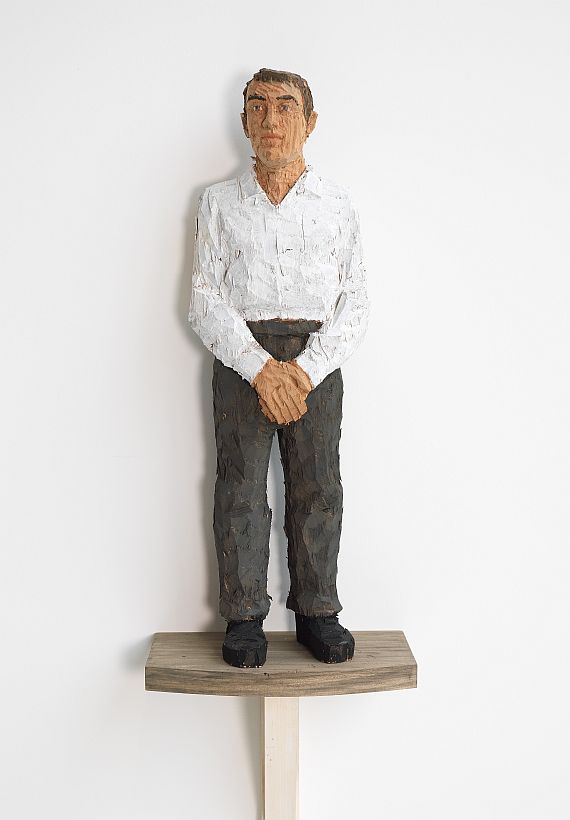
154
Stephan Balkenhol
Stehender Mann, 2007.
Wooden sculpture
Estimate:
€ 40,000 / $ 46,400 Sold:
€ 58,560 / $ 67,929 (incl. surcharge)
Wooden sculpture. Cherry wood, partly bordered in colors
Including console: 243 x 57 x 37 cm (95,6 x 22,4 x 14,5 in)
Stephan Balkenhol, born in 1957 in Fritzlar, Hessen, makes sculptures, which evoke archetypal behaviour patterns of human life and emotions.
Balkenhol studied sculpting at the Hochschule für Bildende Künste in Hamburg under the strictly minimalist artist Ulrich Rückriem from 1976 to 1982. He was awarded two scholarships and then offered a teaching post at the Kunsthochschule Hamburg, where he taught in 1988 and 89. In the following he taught in Frankfurt at the Städelschule in 1991. He has been teaching at the Staatliche Kunstakademie in Karlsruhe since 1992. Balkenhol's work reflects the search of German artists during the 1980s for new means of expression and interpretations of every-day objects. Typical are his larger-than-life human figures and heads carved directly out of raw wooden blocks, which he has been making since 1982. Balkenhol uses traditional tools for his woodwork and considers the wood itself a living matter. Grooves, fissures, splinter and cracks on his sculptures document the creative sculpting process. The figures, the head, the face - often accentuated by painted markings - are sketchy, sometimes almost portrait-like, yet there is always a certain "family likeness" paralleled with the necessary generalization for a large form. The figures convey no subjective emotions and are free of sociological or socio-critical references. They have a completely autonomous presence with a generalizing vagueness, which exemplifies an existential awareness of life of post-modern man.
For his statues Stephan Balkenhol creates a kind of base, a combination of a post and a console. This way the construction is connected to the wall, this impression is increased as the sculpture is executed only half way. Thus the figure accentuates the transition from two- to three-dimensionality and is brought in context with its architectural surrounding. Similar to medieval sculptures, which, for instance, protruded from church walls, Balkenhol‘s sculptures also structure the room and add an architectural imprint. In modern architecture, which often seems to be indifferent, his figures stand out from their environment, however, without entirely dominating it. Like no other contemporary sculptor, Stephan Balkenhol masterly creates a striking combination with architecture.
From November 2008 to February 2009 his works as of 1982 were shown in a large single exhibition in Deichtorhallen in Hamburg. Besides sculptures, his oeuvre also comprises plastic pictures, photographs and drawings. Stephan Balkenhol lives and works in Karlsruhe, Meisenthal and Berlin. [SM].
Including console: 243 x 57 x 37 cm (95,6 x 22,4 x 14,5 in)
Stephan Balkenhol, born in 1957 in Fritzlar, Hessen, makes sculptures, which evoke archetypal behaviour patterns of human life and emotions.
Balkenhol studied sculpting at the Hochschule für Bildende Künste in Hamburg under the strictly minimalist artist Ulrich Rückriem from 1976 to 1982. He was awarded two scholarships and then offered a teaching post at the Kunsthochschule Hamburg, where he taught in 1988 and 89. In the following he taught in Frankfurt at the Städelschule in 1991. He has been teaching at the Staatliche Kunstakademie in Karlsruhe since 1992. Balkenhol's work reflects the search of German artists during the 1980s for new means of expression and interpretations of every-day objects. Typical are his larger-than-life human figures and heads carved directly out of raw wooden blocks, which he has been making since 1982. Balkenhol uses traditional tools for his woodwork and considers the wood itself a living matter. Grooves, fissures, splinter and cracks on his sculptures document the creative sculpting process. The figures, the head, the face - often accentuated by painted markings - are sketchy, sometimes almost portrait-like, yet there is always a certain "family likeness" paralleled with the necessary generalization for a large form. The figures convey no subjective emotions and are free of sociological or socio-critical references. They have a completely autonomous presence with a generalizing vagueness, which exemplifies an existential awareness of life of post-modern man.
For his statues Stephan Balkenhol creates a kind of base, a combination of a post and a console. This way the construction is connected to the wall, this impression is increased as the sculpture is executed only half way. Thus the figure accentuates the transition from two- to three-dimensionality and is brought in context with its architectural surrounding. Similar to medieval sculptures, which, for instance, protruded from church walls, Balkenhol‘s sculptures also structure the room and add an architectural imprint. In modern architecture, which often seems to be indifferent, his figures stand out from their environment, however, without entirely dominating it. Like no other contemporary sculptor, Stephan Balkenhol masterly creates a striking combination with architecture.
From November 2008 to February 2009 his works as of 1982 were shown in a large single exhibition in Deichtorhallen in Hamburg. Besides sculptures, his oeuvre also comprises plastic pictures, photographs and drawings. Stephan Balkenhol lives and works in Karlsruhe, Meisenthal and Berlin. [SM].
154
Stephan Balkenhol
Stehender Mann, 2007.
Wooden sculpture
Estimate:
€ 40,000 / $ 46,400 Sold:
€ 58,560 / $ 67,929 (incl. surcharge)
Headquarters
Joseph-Wild-Str. 18
81829 Munich
Phone: +49 89 55 244-0
Fax: +49 89 55 244-177
info@kettererkunst.de
Louisa von Saucken / Undine Schleifer
Holstenwall 5
20355 Hamburg
Phone: +49 40 37 49 61-0
Fax: +49 40 37 49 61-66
infohamburg@kettererkunst.de
Dr. Simone Wiechers / Nane Schlage
Fasanenstr. 70
10719 Berlin
Phone: +49 30 88 67 53-63
Fax: +49 30 88 67 56-43
infoberlin@kettererkunst.de
Cordula Lichtenberg
Gertrudenstraße 24-28
50667 Cologne
Phone: +49 221 510 908-15
infokoeln@kettererkunst.de
Hessen
Rhineland-Palatinate
Miriam Heß
Phone: +49 62 21 58 80-038
Fax: +49 62 21 58 80-595
infoheidelberg@kettererkunst.de
We will inform you in time.




 Lot 154
Lot 154 